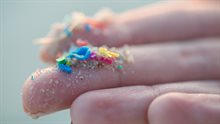Microplastics Lab: measure and identify microplastics
The production of the fossil-based plastics we use in our daily lives dates back to the 1950s. Since then, production has been rising exponentially. So-called microplastics can be released during the production, use, recycling, and destruction of plastics. Would you like to find out if this is happening in your production, use, recycling, or destruction process? Contact us to have this investigated. In the Microplastics Lab, we measure and identify the amount and type of microplastics.

Examples of what you can do in the Microplastics Lab
Plastic consists of different polymer types. A polymer is made up of the same units, called monomers. Together with chemical additives. they form the plastic.
- Measure the amount of microplastics in specific substances or products.
- Identify the microplastics type (which polymers they are), such as:
- PE (polyethylene), which is used for films and plastic bags.
- PP (polypropylene) is used in products such as food trays.
- PET is best known for water and soft drink bottles.
- PVCs are another important category of plastics used in construction (e.g. for sewage pipes).
- Finally, the plastics used for car tyres. This rubber is also a plastic.
In our lab, we have equipment based on the following techniques:
- Electron microscopy (including EDX and CL)
- Light microscopy
- Infrared spectroscopy (micro-FTIR)
- Pyrolysis, gas chromatography, mass spectrometry (pyrolysis-GCMS)
- Laser scattering (SLS)
You have
- You are a seller, manufacturer, brand owner, or end user of plastic products
- You want to identify microplastics in the air, water, a specific substance, or product
- You want to measure microplastics in the air, water, a specific substance or product
You will receive
- Expert guidance in preparing a good research plan
- Qualified laboratory operators
- An indication of the number of particles in the sample
- An indication of the plastics present in the sample
- The size distribution of microplastic particles
- General advice on material design alternatives

